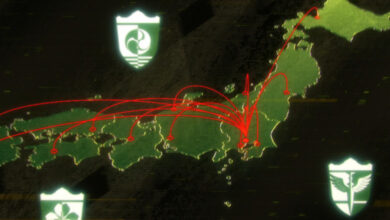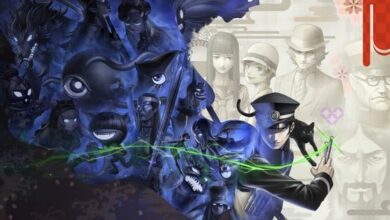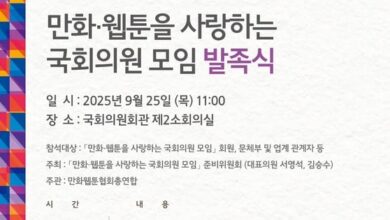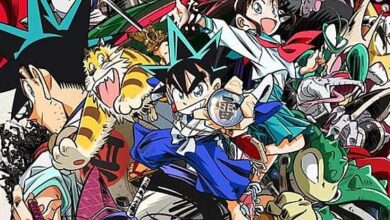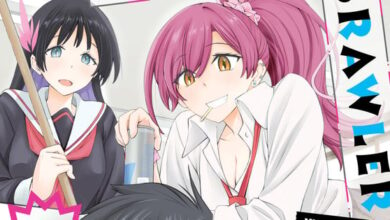Influencers Gigguk, Dillon Goo, and OtakuVS On Making Their Own Anime
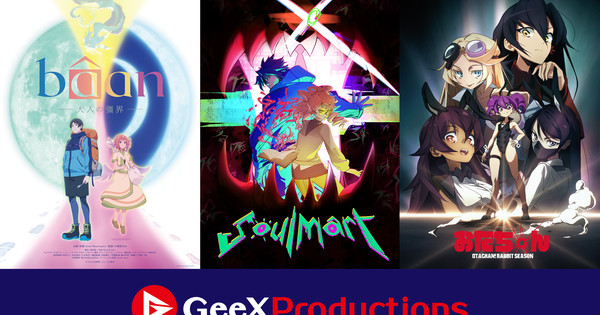
GeeXPlus made waves here at Anime Expo by announcing GeeXProductions, a new IP division. As an internet influencer talent agency, GeeXPlus has been a supportive home for a range of varied and dedicated content creators in the anime culture space. With so many passionate creators under their wing, it doesn’t strain the imagination that they would leverage that talent to make entirely original content. That content output will now include fully original properties, beginning with Gigguk‘s anime short film Bâan -The Boundaries of Adulthood- (Bâan -Otona no Kyōkai-), Dillon Goo’s original 3D Blender animation Soul Mart, and OtakuVS’s indie-animated Otachan! Rabbit Season.
One might scoff at the notion: “Influencers are making anime now?” Such reductive thinking conflicts with the reality that the lines between industry professionals and content creators have been steadily blurring. Naturally, YouTubers and influencers would get closer to the processes and people involved in making the content they love. With the ubiquity of short-form video platforms and the financial viability of these platforms finally reaching some level of equilibrium and stability, you start to realize that this was an inevitable evolution.
We spoke with Rick Gao, Chief Agency Officer and Executive Producer at GeeXProductions, as well as the creators behind the company’s first forays into original animated properties, to get a look at how this all came about and how the landscape is shifting.
What inspires GeeXProductions’ shift from management to IP development?
How does Rick see it reshaping the anime industry’s relationship with internet-native creators? Rick says they operated as a talent management agency for about five years under Kadokawa. “Because of that, we have close vicinity with a lot of anime industry [people], especially in Japan. I took some time to think about what we could do specifically as a company.” That gave Rick a front-row seat to the creative energy of the talent in the GeeXPlus stables and the potential of their storytelling skills.
Being part of the Kadokawa family gave them a direct line to industry resources. “[Gigguk] had already launched his first original anime project. It was very exciting to add on to that and see where we can pivot as a company and to utilize the resources that our group company can potentially provide.” Once momentum within the company started building, Rick identified a Goldilocks zone of creators who had an organic fan base that would support them, but were already doing original IP anime content production. DillonGoo and OtakuVS were natural fits to build off of the groundwork already laid by Gigguk‘s efforts with bâan.
From the sound of it, they’re taking a careful, methodical approach to this new space of variable-length anime content production. While Gigguk‘s bâan is more of a straightforward one-shot film, Soul Mart and Otachan! Rabbit Season are more adapted toward a short-form rollout, with the former even using YouTube as more of a pilot testing bed before committing to full series production. Having Kadokawa‘s support in stress-testing these new release paradigms seems crucial. They can take risks in trying some of these unique ventures by putting the weight of veteran industry professionals to maximize the chances of success. If those prove successful, it will only lower the bar for others to follow in those footsteps.
Difficulties in getting studios or individuals in the industry on board
Gigguk said that it’s more about chemistry and passion than logistics. “The reality is that it’s not about being able to get the studio on board. The studio needs to be passionate about the projects you work on. The studio needed to want to adapt it before even talking about scheduling. Or ‘can you even take on this work?’” Studios are actually very willing to take these pitches seriously, and if there’s a spark, they will come to the table with their industry expertise and work together to realize the goal. “It was not a one-sided conversation. We both worked to help each other, to make a project that we were both passionate about.”
The unique creative or production challenges of working with YouTube-first distribution
Some say it’s not worth it. “I’d say YouTube a year or two ago, maybe three years, YouTube and animation were like oil and water. It didn’t mix. People were saying animation is not viable for YouTube,” says OtakuVS. “But we’ve seen, in the past year, an absolute explosion of indie anime and indie animation.” OtakuVS’s perspective is informed by years of hard work. As an indie animator himself, grinding it out pen to pad and building a following with his work, he’s seen the shift first-hand. “YouTube is becoming more and more well-known as somewhere that you can consume an entire series,” OtakuVS continues. “And for independent creators … it’s very empowering. It’s like a new playground for everybody to kind of get involved in.”
Rick Gao and the folks at GeeXPlus see the potential there, so GeeXProductions seems like a no-brainer. “Industry people, especially overseas in Japan, [are] taking that playground quite seriously in terms of its reach,” OtakuVS adds. What we’re seeing is the barriers of traditional pipelines breaking down. As creators release content directly to audiences and build a following, the industry is taking notice and starting to reshape itself to pursue those opportunities.
“Successful pilots have been greenlit on YouTube several times now,” DillonGoo says, “but the biggest thing that has happened recently that’s legitimized it is the monetization strategies. People have started to figure out what works, and that meta in the industry is starting to evolve in a way that feels more sustainable for animation.”
“The monthly subscription model, merchandise, and other various ways to let the audience participate in a community can build support that can enable these kinds of creations. The advent of YouTube Shorts has had a noticeable effect, too,” DillonGoo says. The presence of Shorts is “making long-form content feel more worthwhile.” That rings true, since the context of short-form content platforms like YouTube Shorts and its ilk, like TikTok and Instagram, means viewers expect quick hits and attention-grabbing content. “People are generally more patient with long videos because that’s what they’re signing up for.”
After years of reviewing anime, what made Gigguk take the leap from critic to creator with bâan?

To him, this was always the goal, and that everything he’s done in his career so far has led up to this. “It was always at the back of my mind to meet the right people, get the right connections, to get some kind of a project made.” Gigguk has built a following on YouTube, releasing anime commentary and critiques, and is one of the hosts of a popular show called Trash Taste. He’s a strong believer that the storytelling skills he’s developed over the years of creating content that helped him in this moment. “It’s a skill that you can naturally develop as you do YouTube, and to bring that skill … to making an original story. You just need to learn how to pivot it to a different medium.”
After baring himself to viewers with spicy yet earnest takes about the creative works of others, he must feel especially vulnerable now that the tables have turned and it’s his creative work under scrutiny. “I would say honestly, this project has made me feel the most vulnerable as someone who is an internet personality. I’ve shared a lot of aspects of my life, and yet I’ve never felt as bare as I have with this project.” After pouring his soul into bâan, Gigguk appreciates how it feels to suddenly have all eyes turned toward him.
Has his perspective on anime changed now that he’s been on the other side of it? “Yes,” Gigguk says definitively. “It’s much easier to critique. I knew that anyway, but now experiencing it, you internalize it in a much deeper way.” Now that it’s his work under the spotlight, it’s a newfound appreciation for the struggle of production and how so many factors can influence the result. “Whenever I look at a piece of work, even if something isn’t always of the highest quality, I’ve realized that no one wants to make something bad.”
I was curious to know more about Euthania, the backdrop for bâan, and Gigguk‘s connection to it. It’s inspired by Southeast Asian and Thai mythology, which is something we don’t see in anime very often. According to Gigguk, the first draft of the script had a much more typical fantasy world, but as he worked with the studio to iterate on it, he realized he wanted to take a different tack. “[If] I’m going to treat this as my only opportunity to do this dream thing, and if there was one thing I would want to do, it’s to introduce some of my own culture, some of my background. I’m from Thailand … and I don’t think a lot of people from my region get to showcase a part of our culture in a way that people aren’t already familiar with.”
He’s right. It’s natural and expected that most creative projects will reflect the worldview and background of those in the driver’s seat. With a cross-cultural production effort like bâan, it opens the door to new, fresh perspectives to delve into and bring audiences something they’ve never seen before.
Knowing more about where DillonGoo felt Soul Mart was intended to land tonally, given that it had been described as a horror comedy action series “for people who don’t like excessive violence or sex.”
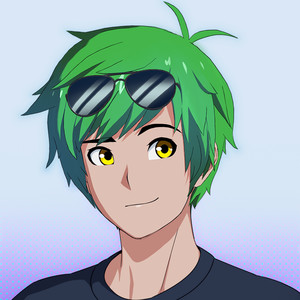
“The most important thing was being able to show a western audience that animation isn’t just for kids,” DillonGoo says, “and it’s also not just rated M.” It’s true that what tends to rise to the top are the polar opposite ends of the spectrum. Much of the middle ground has been occupied by anime. Soul Mart is intended to strike a balance, featuring a good, entertaining story, and is still deep and feels personal to those with whom the themes and subject matter resonate.
“Soul Mart, ultimately, at its core is a story about people not fitting into the modern world,” DillonGoo says. “It’s something that plagues a lot of younger people today – young adults, people entering the workforce – and they don’t have … the best stories to express the struggles they’re going through.” DillonGoo has built his own animation studio, and they’ve developed a custom build of Blender for use in making 3D anime. It’s been seeing increased adoption, and even caught the attention of the Blender software team itself. Not only has this in-house engine proven itself with the quality work they’ve been generating, but it also gives them a lot of flexibility to incorporate and merge styles.
Soul Mart is one such example. They’re putting the base features they built through their paces, and they’re exploring new and exciting ways to blend styles. “One of the biggest things we want to push right now is 2D integration. Grease pencil is already a really powerful tool in Blender that does 2D animation within the 3d scene, which is fantastic. We’ve brought on more 2D animators than we’ve ever had.”
Lines continue to blur! It’s interesting to see GeeXProductions throw their weight behind this kind of innovation and knowledge-sharing, because it’s yielding interesting results.
Going Short-Form

OtakuVS has been diligently grinding away as an animator, releasing short-form animations on YouTube and watching this evolution unfold. Otakuchan! Rabbit Season is his new effort under the banner of GeeXProductions, and is described as an homage to gritty OVAs of the 80s and 90s. Of those gritty elements, OtakuVS says he tried to pull a lot from the actual action choreography of 80s and 90s titles like Ninja Scroll and Gunsmith Cats. “I don’t want anything too bombastic or fantastical. I want to see raw action.”
Otakuchan! Rabbit Season will be released as 5-minute episodes. That’s not unprecedented, but the landscape has changed since the days of quick-hit shows like Di Gi Charat. “That was something where we had to take YouTube into consideration.” YouTube comes with certain pressures, like making your audience wait too long for something new. “If we waited for three years and released it as one big thing, it might have just been taking too long, even for ourselves.” The 5-minute format seems to be working well to keep the action rolling, with the story unfolding throughout a single night and each episode ending on a juicy cliffhanger that leads into the next segment.
OtakuVS knows from experience how hard it can be to find success as an animator on the internet. Hence, a word of wisdom to aspiring animators trying to make their thing and put it into the world. “I’m pointing at you, to the aspiring animator, trying to get into the anime industry.” You can tell from his tone that he’s administering a strong dose of reality. “It will be tough. It will be suck. It will be hard, but now is the time for you to get in. The genie is out of the bottle. Four or five years ago, it was very difficult to even find the information to understand the anime pipeline. Don’t give up. Keep going. Keep learning. It will be bad at first, but it will get better, and your time will come where you’ll have that moment.”
“The biggest hurdle is just finishing that thing,” Gigguk adds. “I know so many people who have the same dream as me and have stopped halfway. The first step to going out and achieving a project of this scale is just finishing your mini project yourself, even if it sucks.” DillonGoo shared some of the wisdom he’s gained through the struggle as well: “One of the best pieces of advice I’ve ever received was ‘finished is better than perfect.’”
GeeXProductions is a new and experimental initiative, so people will be watching closely how these first forays into original content are received. Still, Rick is clear-eyed about his role and unfazed by the pressure. “Ultimately, it’s about promoting indie anime. I feel very lucky to be able to work with such passionate, creative creators with such an amazing work ethic. We’re ultimately just a support team. Their projects are the shining star of all this, and it couldn’t be done, or it couldn’t have happened without the fans showing their support.”
It sounds like smashing those Like and Subscribe buttons is having a positive effect.
